The Stock Market’s 2021 Surprise: A Booming Economy and Tepid Returns

The current recession wasn’t due to too much risk-taking but a virus that forced a shutdown.
Courtesy of NYSE
An abnormally bad year brought abnormally large gains for the stock market in 2020. A return to normalcy, however, could bring disappointment.
The Dow Jones Industrial Average has advanced 5.8% in 2020, to 30,179, after gaining 0.4% this past week. The S&P 500 is up 15% this year, to 3709, after rising 1.3% for the week—even though Tesla (ticker: TSLA), which has soared 731% in 2020, won’t join the index until Monday. The Nasdaq Composite has jumped 42% in 2020, to 12,756, after gaining 3.1% for the week. Even the Russell 2000 has gotten into the act, climbing 18% in 2020.
These gains came despite the slew of bad news that hung over the year: The coronavirus that shut down the economy and killed more than 300,000; the nonstop attention to politics, which made every tick of the stock market a referendum on the election; and the death of George Floyd and the protests that followed. It’s a reminder that the market doesn’t have emotions, doesn’t respond to cues that individuals might, and values what might happen over what has happened.
Next year promises to be less traumatic. Just this past week, people in the U.S. started getting vaccinated against the coronavirus, with some expecting 100 million Americans to have received the shots by the end of the first quarter. The return of daily life to something that more closely resembles normal should provide an incredible boost to the economy, one that finally helps the U.S. escape the slow-growth malaise it was stuck in under both Barack Obama and Donald Trump, when U.S. gross-domestic-product growth had trouble getting to 3% in any given year.
In fact, the biggest mistake investors might be making is looking at the past decade and extrapolating into the future. The last recession was stoked by a financial crisis that left banks with wounded balance sheets, muted risk appetites, and stagnant growth, thanks to the lack of major fiscal stimulus and a Federal Reserve that was too worried about inflation that never arrived.
This time around, trillions of dollars in fiscal stimulus was doled out immediately—and more is likely on the way. The Fed also seems to realize the mistake it made following 2008’s financial crisis and has promised not to tighten monetary policy until 2023.
Most important, the current recession isn’t due to too much risk-taking, but rather to a virus that forced a shutdown. That means the recovery should be faster and stronger than the one that began in 2009, says Christopher Harvey, U.S. equity strategist at Wells Fargo Securities. “It’s not a J, K, X-Y-Z, or whatever letter you want to throw at it recovery,” he argues. “It’s a V-shaped recovery.”
That’s certainly not the consensus view. Economists predict the U.S. economy will grow at a 4% clip in 2021, faster than what had been customary from 2010 through 2019, but not enough to undo the damage done by the coronavirus recession until 2022 or 2023. There’s a good chance economic growth will be much faster than that, says Michael Darda, chief economist at MKM Partners, who estimates that GDP will expand by 4.5% to 6.5% next year, while inflation will average 2.5% to 3.5%.
“The second half of the year should be very strong, as vaccine rollout and stepped-up therapeutics ramp reopening efforts,” he says. “The multi-trillion buildup of liquid assets in the household sector will be ‘run down’ as households spend on many services (leisure and hospitality, etc.) they could not spend on during 2020.”
But as we’ve heard so many times in 2020, the economy isn’t the market. It’s not that growth isn’t good for stocks—it absolutely is. A booming economy means that S&P 500 earnings next year could grow by 15% to 20%, Darda says. But strong growth could also cause Treasury yields to rise, and that would put pressure on market valuations, particularly those of high-priced growth stocks in the tech, communications-services, and consumer-discretionary sectors. Investors use Treasury yields as a risk-free rate, and the higher they go, the more valuations for growth stocks can fall. “The market will be flat to up/down single digits, as multiples contract with higher discount rates,” Darda says.
Wells Fargo’s Harvey agrees. He predicts that 2021 will see investors rotating out of highflying big tech and into cheaper, more economically sensitive stocks. But tech is an enormous part—28%—of the S&P 500. Apple (AAPL) alone makes up nearly 7% of the index, and Microsoft (MSFT), more than 5%. If these stocks were to tread water or—gasp!—even drop, the index could have trouble making a lot of headway.
“If they’re not going to work, it will be a big weight on the index,” says Harvey, who has a year-end 2021 target of 3850 on the S&P 500.
His advice: Buy stocks with high “Covid beta”—the ones most sensitive to the market’s rise and fall, based on good or bad coronavirus news—because they will benefit the most as life returns to normal. They include Darden Restaurants (DRI), which gained 3.1% this past week despite providing a downbeat revenue outlook, MGM Resorts International (MGM), and Whirlpool (WHR).
Sure, there will be reasons to doubt that the rotation is real. This past week, the Nasdaq beat the Dow by more than two percentage points. Just remember, that’s normal too.
Read more Trader: Dogs of the Dow Stock-Picking Strategy Didn’t Work This Year. It Could in 2021.
Write to Ben Levisohn at Ben.Levisohn@barrons.com




